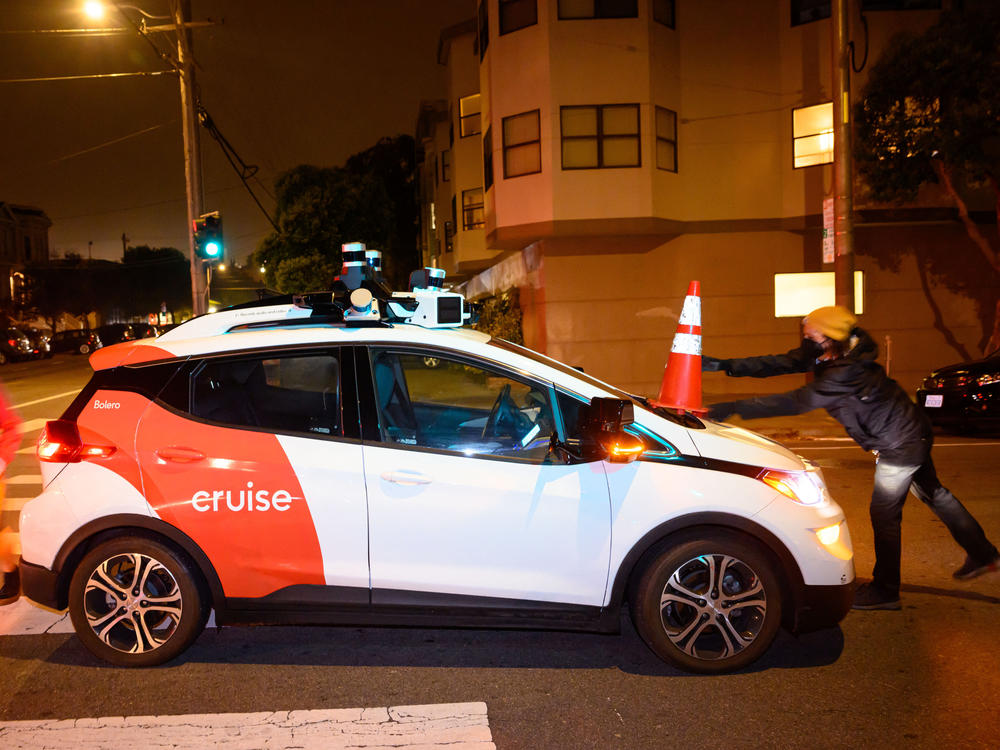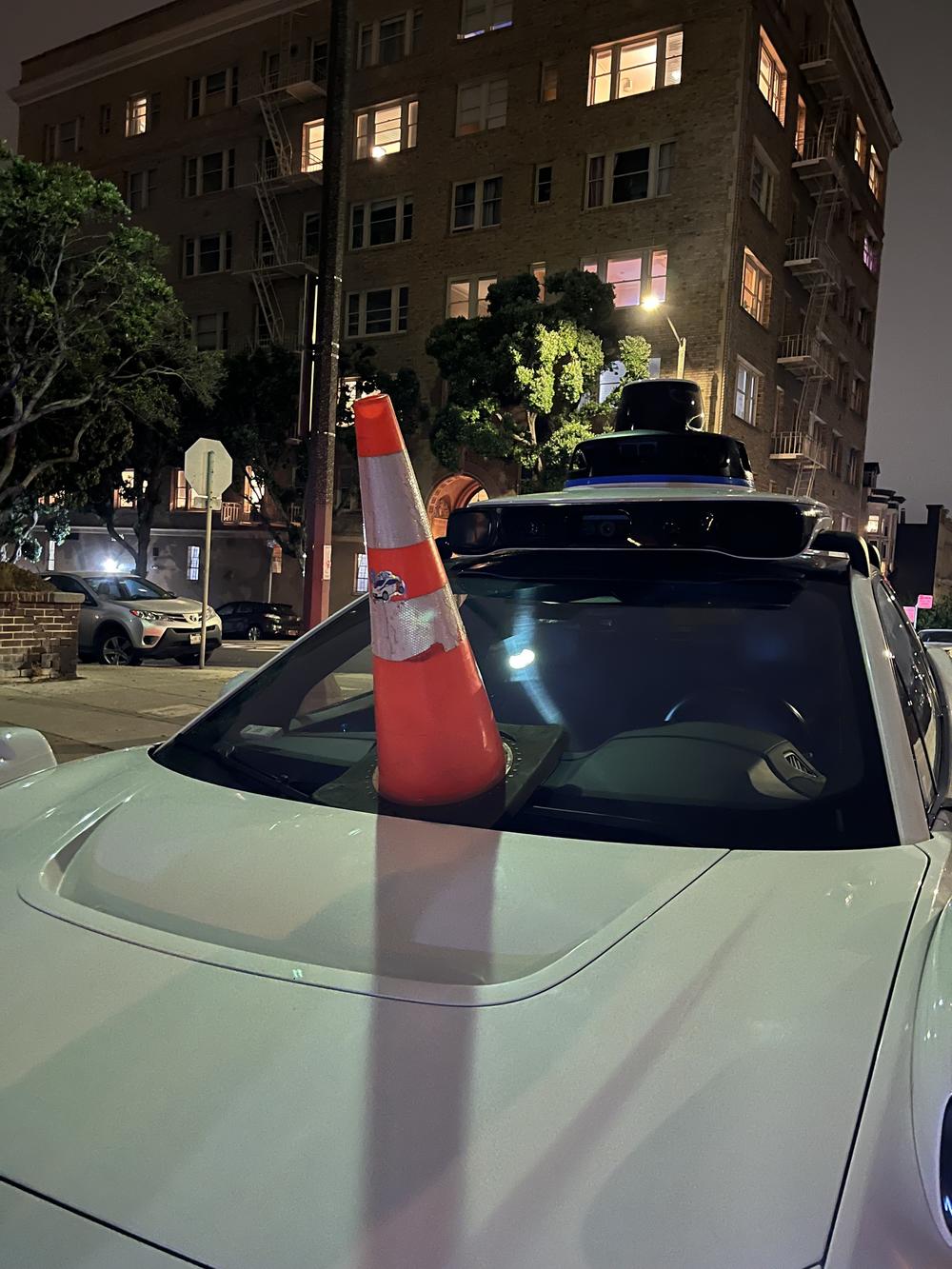Section Branding
Header Content
Armed with traffic cones, protesters are immobilizing driverless cars
Primary Content
Two people dressed in dark colors and wearing masks dart into a busy street on a hill in San Francisco. One of them hauls a big orange traffic cone. They sprint toward a driverless car and quickly set the cone on the hood.
The vehicle's side lights burst on and start flashing orange. And then, it sits there immobile.
"All right, looks good," one of them says after making sure no one is inside. "Let's get out of here." They hop on e-bikes and pedal off.
All it takes to render the technology-packed self-driving car inoperable is a traffic cone. If all goes according to plan, it will stay there, frozen, until someone comes and removes it.
An anonymous activist group called Safe Street Rebel is responsible for this so-called coning incident and dozens of others over the past few months. The group's goal is to incapacitate the driverless cars roaming San Francisco's streets as a protest against the city being used as a testing ground for this emerging technology.
Over the past couple of years, driverless cars have become ubiquitous throughout San Francisco. It began with human safety drivers on board who were there to make sure everything ran smoothly. And then, many cars started operating with no humans at all.
They're mostly run by Cruise, which is owned by GM, and Waymo, which is owned by Google parent company Alphabet. Both companies have poured billions of dollars into developing these autonomous vehicles. Neither Cruise nor Waymo responded to questions about why the cars can be disabled by traffic cones.
Waymo says it has a permit for 250 cars and it deploys about 100 at any given time. Cruise says it runs 100 in San Francisco during the day and 300 at night. The Department of Motor Vehicles made Cruise cut that number in half after one of its cars collided with a firetruck last week.
Street theater protests are nothing new in San Francisco
Earlier this month, the California Public Utilities Commission voted 3-1 to let the two companies run their vehicles at all hours of the day picking up passengers like taxis.
The lead-up to the commission's vote prompted the Safe Street Rebel group to start "coning," as they call it. Members have long used street theater shenanigans to gain attention in their fight against cars and to promote public transportation.
Coning driverless cars fits in line with a long history of protests against the impact of the tech industry on San Francisco. Throughout the years, activists have blockaded Google's private commuter buses from picking up employees in the city. And when scooter companies flooded the sidewalks with electric scooters, people threw them into San Francisco Bay.
"Then there was the burning of Lime scooters in front of a Google bus," says Manissa Maharawal, an assistant professor at American University who has studied these protests.
She points out that when tech companies test their products in the city, residents don't have much say in those decisions: "There's been various iterations of this where it's like, 'Oh, yep, let's try that out in San Francisco again,' with very little input from anyone who lives here."
That gets to the crux of Safe Street Rebel's protest. The group only agreed to speak to NPR if they could remain anonymous because it's unclear if what they're doing is legal.
"We thought that putting cones on these [driverless cars] was a funny image that could captivate people," says one organizer. "One of these self-driving cars with billions of dollars of venture capital investment money and R&D, just being disabled by a common traffic cone."
First responders aren't happy with driverless cars
Safe Street Rebel has cataloged hundreds of near misses and blunders with Cruise and Waymo vehicles over the past few months — even without traffic cones.
The cars have run red lights, rear-ended a bus and blocked crosswalks and bike paths. In one incident, dozens of confused cars congregated in a residential cul-de-sac, clogging the street. In another, a Waymo ran over and killed a dog.
"We don't really need traffic cones to show how vulnerable they are," says the Safe Street Rebel organizer.
Both Cruise and Waymo say their vehicles are far safer than human drivers and compared to humans they've had relatively few incidents. They say they've driven millions of driverless miles without any human fatalities or life-threatening injuries. An Uber self-driving car, operating in full autonomous mode and with a safety driver in the vehicle, killed a pedestrian in Arizona in 2018.
Safe Street Rebel isn't the only group that's had issues with the autonomous vehicles. San Francisco's police and fire departments have also said the cars aren't yet ready for public roads. They've tallied 55 incidents where self-driving cars have gotten in the way of rescue operations in just the past six months.
Those incidents include driving through yellow emergency tape, blocking firehouse driveways, running over fire hoses and refusing to move for first responders.
Autonomous vehicles are programmed to be overly conservative
Ziwen Wan, a Ph.D. candidate in computer science at University of California, Irvine, has studied why driverless cars may be acting this way. He used open source data for his research, so his findings aren't based specifically on Cruise and Waymo. Wan found that ordinary objects on the road can lead to dangerous driving behavior. Part of this, he says, is because the cars are programmed to be overly conservative.
"The software can make the autonomous vehicle behave as conservatively as possible because a safety violation would be very serious," Wan says. "But this may lead to concerns on the other side, like in some cases, even though it's safe it will fail to drive normally."
That abnormal driving includes abrupt halts, swerves, erratic behavior or just stopping in the middle of the road.
"The traffic cone protest is an example of how things in the real world can really confound machines, even ones as sophisticated and finely tuned as this," says Margaret O'Mara, a history professor at the University of Washington who studies the tech industry. "It's a reminder that in this very high-tech world, the most low-tech things can literally put a wrench in the machine."
Despite the bumps in the road, both Waymo and Cruise are rapidly expanding their robo-taxi programs throughout the U.S. Waymo is already giving rides in Phoenix and is testing with human safety drivers in Los Angeles and Austin. And Cruise is offering rides in Phoenix and Austin and testing in Dallas, Houston, Miami, Nashville and Charlotte.
Meanwhile, in San Francisco, members of Safe Street Rebel continue to go out at night and stalk the vehicles one cone at a time.
Copyright 2023 NPR. To see more, visit https://www.npr.org.


